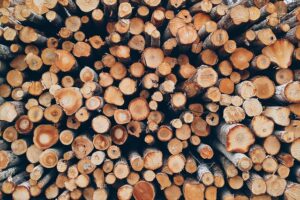Homesteading Skills: How to Harvest Firewood

Harvesting firewood is not just about chopping down trees; it’s an art that requires precision, patience and a little bit of knowledge about the nature of wood. Knowing how to harvest firewood is an important homesteading skill.
Sustainable harvesting of firewood involves responsible practices that preserve and protect our forests for future generations. This method involves selecting only mature trees for harvest, ensuring a minimal impact on the forest’s ecosystem. Furthermore, it prioritizes the use of dead or fallen trees, which not only reduces waste but also minimizes the need to cut down living trees. It’s also crucial to regulate the frequency of harvest to allow the forest enough time to naturally regenerate. By adhering to these strategies, we can help balance our need for firewood while ensuring the longevity and health of our forests.
Tools for Harvesting Firewood
To carry out a sustainable harvest of firewood, there are several key tools you’ll need. First and foremost, a reliable chainsaw is crucial for efficiently cutting through wood. Safety gear including gloves, safety glasses, and sturdy footwear are also essential to protect you during the harvesting process. A splitting maul is necessary for dividing logs into usable firewood, and a hand saw may be useful for more precise cuts. Lastly, a wheelbarrow or a heavy-duty tarp can assist in transporting the harvested wood from the forest to your storage area.
The Best Time to Harvest Firewood
The best times to harvest firewood significantly depend on the type of wood and your geographical location. However, generally, late winter and early spring are optimal times. Harvesting during this period gives the wood ample time to dry out before the cold season. Conversely, summer and early fall are considered less ideal due to the high sap content in trees and the increased difficulty in drying wood. Nevertheless, always remember that local conditions and tree species can influence the best time for harvesting, so it’s advisable to consult local forestry resources or professionals to determine the best harvest time in your area.
How to Age Firewood
Aging or drying firewood is an essential step in the process of preparing firewood for use. Freshly cut wood, also known as green wood, has a high moisture content that makes it unsuitable for burning. When green wood is burned, it produces a lot of smoke, burns inefficiently, and can cause a build-up of creosote, a tar-like substance that can accumulate in your chimney or stovepipe, creating a fire hazard. On the other hand, properly aged or dried firewood, known as seasoned firewood, has a lower moisture content, burns more efficiently, produces more heat, and reduces the risk of creosote build-up. Therefore, aging firewood before use is not only important for efficiency and heat production but also for safety.
Steps to properly age firewood
- Cut the Firewood into Smaller Pieces: Start by cutting the harvested logs into smaller, manageable pieces, typically 16 to 20 inches long, depending on your fireplace or stove size. Smaller pieces have more surface area exposed to the air and dry out quicker.
- Split the Logs: After cutting, split the logs into quarters using a wood splitter or axe. This process is necessary because the moisture in the wood escapes more easily from the split surfaces than from the outer bark.
- Stack the Wood: Next, stack the split wood off the ground to prevent it from absorbing moisture. Ensure that the split side is facing outwards to allow maximum exposure to the wind and sun.
- Cover the Wood: Protect the stacked wood from rain and snow by covering the top with a waterproof material such as a tarp. Remember to leave the sides exposed to facilitate air circulation.
- Let the Wood Dry: Allow the wood to dry out for at least six months, or until its moisture content is below 20 percent. You can use a wood moisture meter to check the wood’s moisture level.
- Store Properly: Once the wood is sufficiently dry, store it in a woodshed or another protected area until it’s ready to use. Make sure it remains dry and off the ground.
How to Stack Firewood for Drying
Proper stacking is an essential step in the process of drying firewood. Here’s how to do it effectively:
- Choose a Suitable Location: The ideal location for stacking your firewood is a dry, sunny spot with good air circulation. Avoid areas that are prone to flooding or dampness.
- Prepare the Ground: Lay down a base of treated wood or pallets to keep the firewood off the ground and prevent moisture absorption.
- Stack the Logs: Start stacking the firewood on the prepared ground, placing the split side downwards. Stack wood in a single row, with each piece touching the next, for maximum exposure to the wind and sun.
- Ensure Stability: It’s important to ensure your firewood stack is stable to prevent it from toppling over. You can do this by stacking the ends of each row slightly higher, creating a ‘log cabin’ style end.
- Create Space for Airflow: Leave spaces between the stacks to improve airflow, which can help speed up the drying process.
- Cover the Stack: Protect the wood from rain and snow by covering the stack with a waterproof cover. However, don’t cover it completely as this could trap moisture; just cover the top, leaving the sides open for ventilation.
Remember to keep an eye on your firewood as it dries, restacking pieces that may fall and checking for signs of pests. With this stacking method, your firewood should be ready for use in no time.
Optimal Conditions for Drying Firewood
To effectively dry firewood, some conditions are more ideal than others. The best time to start the drying process is in early spring when the weather is starting to warm up. The combination of longer daylight hours and warmer temperatures creates the perfect environment for drying out your wood.
Humidity is another factor to consider. Low humidity levels are preferable as they allow the moisture within the wood to evaporate more quickly. Higher humidity can slow the drying process, so it’s beneficial to monitor the weather and take advantage of drier periods if possible.
Exposure to breeze and sunlight is crucial. Sunlight helps to evaporate the water content, while wind aids in dispersing the moisture, speeding up the drying time. As a result, your chosen stacking location should ideally be open to elements of nature but shielded from excess moisture such as rain or snow.
Lastly, the type of wood can affect drying time. Hardwoods, like oak and hickory, have a high-density and will require more time to dry than softwoods, like pine and fir. Regardless of the wood type, remember to split the logs to a manageable size, as smaller pieces will dry faster than larger ones.
Time Needed for Drying Different Types of Wood
The drying time of firewood can significantly vary depending on the type of wood. As a general guideline, most softwoods such as pine and fir can dry out sufficiently in approximately 6 months if conditions are optimal. However, hardwoods like oak or hickory, because of their denser nature, often require a longer drying period of around 1 to 2 years. Fast-drying species like ash can be ready in as little as 6 months, even without optimal drying conditions. It’s essential to note that these durations are estimates and actual drying time can be influenced by factors such as weather, humidity, and how the wood is stacked. Always check your wood before burning to ensure it’s adequately dried.
Conclusion
In summary, the choice of wood for firewood and its proper harvesting and aging are crucial for optimal burning efficiency. Softwoods like pine and fir tend to dry faster due to their lower density, making them a good choice for those who require firewood in a shorter timeframe. However, hardwoods such as oak and hickory, while requiring a longer drying period of 1 to 2 years, offer a higher heat output and burn for a longer time. Fast-drying species like ash can serve as a balance between the two, ready in as little as 6 months. The harvesting process also plays a vital role, with the wood needing to be split into manageable sizes and dried under optimal conditions of sunlight and wind exposure. Remember, these drying durations are estimates; actual timing will depend on various factors including local weather and humidity levels. Always ensure your firewood is adequately dried before burning for the best results.

